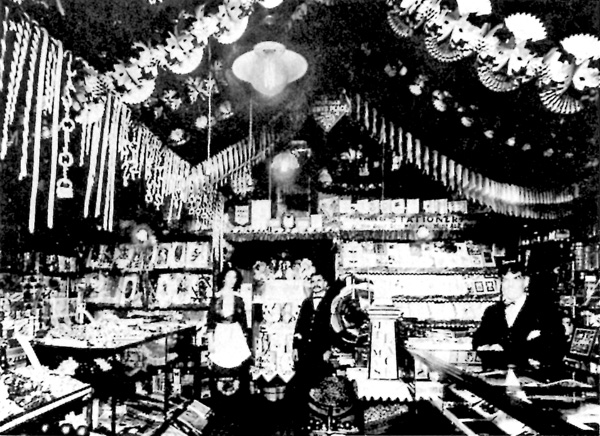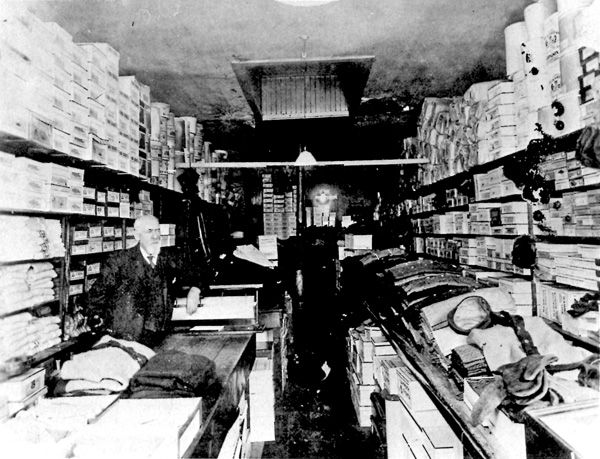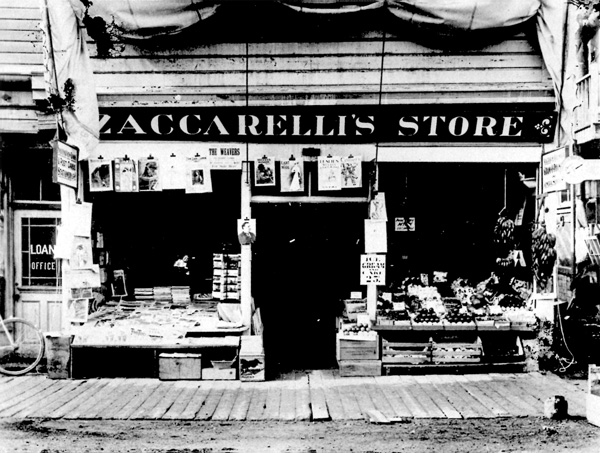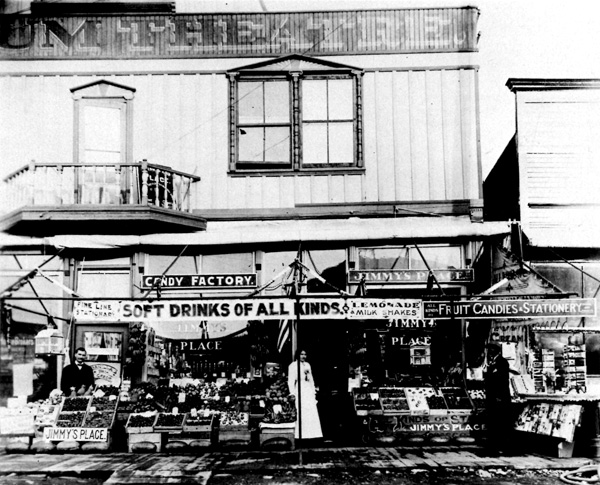|
|
 |
Canadian Historic Sites: Occasional Papers in Archaeology and History No. 26
Grubstake to Grocery Store: Supplying the Klondike, 1897-1907
by Margaret Archibald
Conclusion: The Well-Appointed Ghost Town
After 1905 it was obvious that the Klondike valley was to be divided
among a few large corporate claim-owners whose technological and
financial manipulation of the hydraulic and dredging processes would
secure control of gold mining in the 20th century.1
Population declined, and for those who remained there was a growing
dependence on these large gold-mining companies for jobs — and, in
the case of the merchant, for sales.
By 1906 most claims were mining camps whose owners stocked goods from
Dawson wholesale firms to feed their employees.2 Needless to
say the system was a fine one for those wholesalers who could snap up
one of these contracts (usually one of the two surviving trade
corporations, the NC Company and the NAT&T Company) but many of the
smaller firms were forced to close. Even then, the price offered by the
gold companies was barely above cost, and the profits of those companies
which did manage to survive were minimal. This new existence as a
company town was itself short-lived, for in 19073 Guggenheim,
the backers of one of the largest of the gold companies, announced that
henceforth they would send their orders for provisions to the west
coast. From that point forward, commercial Dawson was destined to
continue as a shadow of its former active self.
But Dawson was an adamant ghost town and a reluctant has-been. While
most of her early courtiers had loved her and left her, ten years after
her prime she did retain a few sympathetic admirers. Among them was E.O.
Ellingsen, who appreciated her still for her antiquated glamour.
Ellingsen's craft was photography, and for his models he chose Dawson's
most elegant parlours, emporia and sidewalks. In three 1909 photographs
of some of the city's finer shops (the NC Company's, Zacarelli's and
Jimmy's palace of sweet fruits and stationery — see Figs. 39, 56, 58
and 59) Dawson appears as a young Edwardian lady, only slightly
overdressed for the occasion.

56 Jimmy's Place, Dawson (tobacco, stationery and confections), ca.
1913. Note the electric lighting.
(Public Archives Canada, C
21095.)
|

57 Daniel Kearney, a Dawson dry goods merchant, ca. 1905.
(Public
Archives Canada, C 16462.)
|

58 Zacccarelli's store in Dawson, ca. 1908. Photo by E.O. Ellingsen.
(Public Archives Canada, C 8121.)
|

59 Jimmy's Place, Dawson, ca. 1910. Photo by E.O. Ellingsen.
(Public
Archives Canada, C 8128.)
|
By that time, her riverfront façade was more rococo than ever.
While the elaborate effect of storefront finery was really no more
baroque than that found on King, Queen or Front streets in any other
Canadian city, there was something stilted about Dawson's streetscapes.
The original boom-town front — a matter of economy in times of
astronomical lumber prices — had been distorted beyond recognition
by the studied use of flourishes and curlicues.
Perhaps one had to see what lay behind that façade. While
Second and Third avenues had once been lively thoroughfares and still
did contain some thriving stores, the whole area was
on the verge of becoming a desert of secondhand shops & junk
yards. Some of the buildings were already vacant and the windows boarded
up. The secondhand shops were jammed with the refuse of the gold rush:
stoves, furniture, goldpans, sets of dishes, double-belled seltzer
bottles, old fur coats, lamps, jardiniers, cooking utensils, rubber
boots, hand organs, glassware, bric-a-brac silver, and beds, beds,
beds.4
One of the few general merchants to survive the heyday of the
specialized retailer was E.S. Strait, his specialty, auctioneering and
secondhand goods.5
By 1909, 11 grocers, 4 general merchants, 12 dealers in dry goods, 8
dealers in hardware, 4 secondhand traders and 4 fruit, candy and tobacco
sellers remained in town to supply the 2,000 inhabitants.
Amalgamation and consolidation continued. In 1912 the NAT&T
Company was forced to withdraw, leaving the NC Company as the final
winner of the retail monopoly, a position which the San Francisco firm
held in the Yukon until 1969. In that year the first of the great
Pacific northwestern trade monopolies withdrew from its last bastion of
retail sales, Whitehorse, just a little more than a century after its
incorporation as a sealing enterprise. The sale left Taylor and Drury as
the leading multi-purpose department store in Whitehorse. Founded upon a
partnership formed 71 years earlier on the trail of '98, Taylor and
Drury had worked from a keen sense of enterprise and an intuitive
knowledge of what the goldseeker would buy at any price. "Buying from
the downhearted and selling to the stouthearted:" the motto held true on
the trail, along the river and on the wharves. Later conditions,
however, called for a more rational and streamlined approach to
ordering, shipping and marketing. The decade following the gold-rush
demanded commercial skills of a different kind.
Hundreds of swappers, traders, pedlars and scowmen had swarmed over
the passes, surprised to find their much-sought gold in a form which was
crystallized, condensed, evaporated and tinned. Few of them outlasted
the great monopolies as did Taylor and Drury, but then longevity had not
been their goal. Their commercial careers had been for the most part
brief; a few were notable and many were nameless. In Dawson, the
permafrost has equalized their abandoned monuments. The false fronts sag
and the nearly illegible grey names no longer speak of proud
reputations. Lurching into the street, Strait's secondhand store still
proclaims its "tobaccos, furniture, crockery, clothing, tents, guns,
ammunition." Once there was a grocer and jobber who could declare, in
truth, that he could provide "anything from a needle to a
steamboat."6
|

